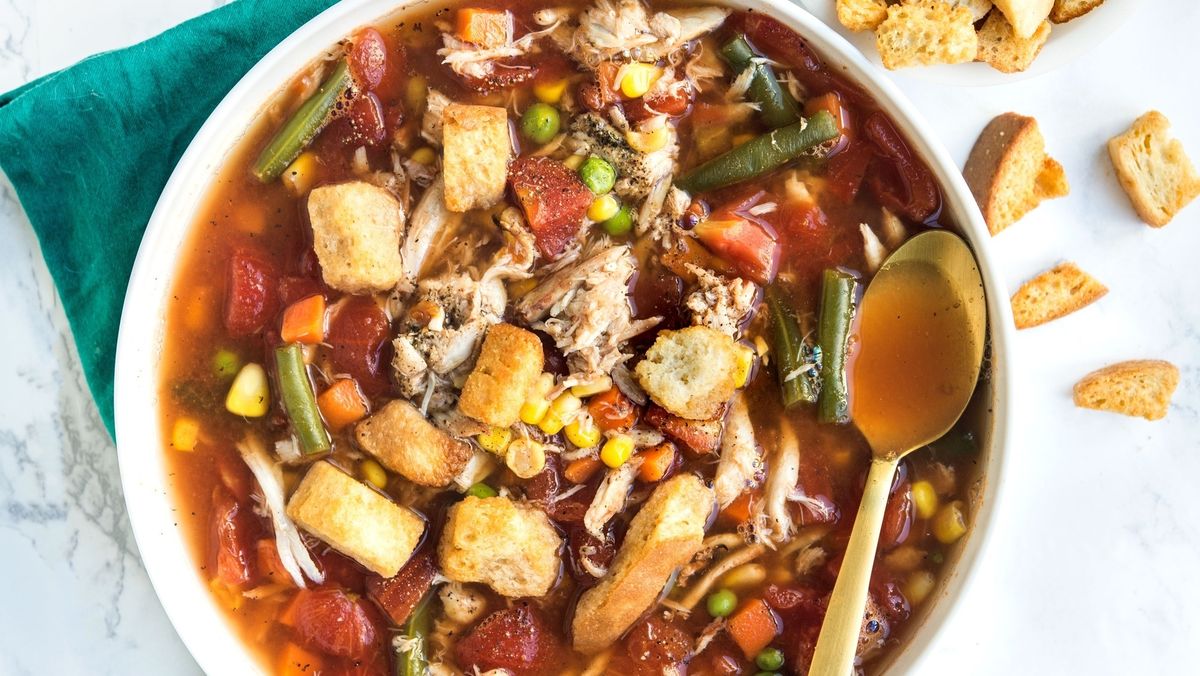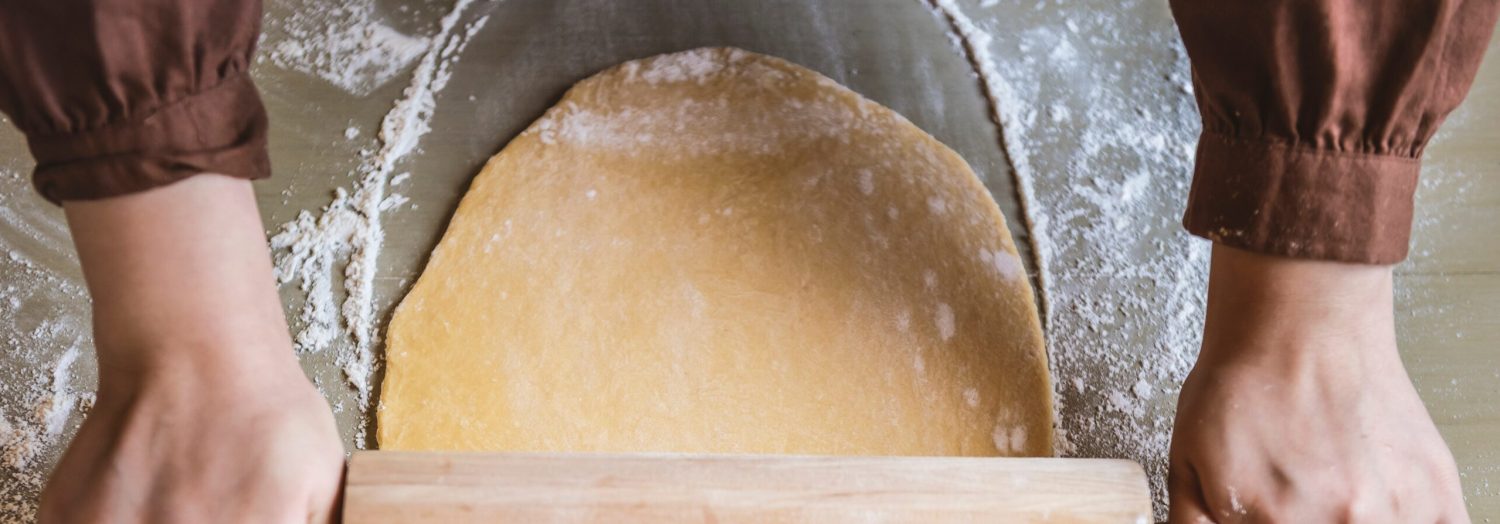Maryland crab soup is a hearty and flavorful dish that brings the taste of the Chesapeake Bay right to your table. This soup is packed with fresh vegetables and succulent crab meat, making it a perfect choice for a comforting meal.
When preparing this recipe, you might need to pay special attention to the crab meat. Fresh crab meat can be found at seafood markets or the seafood section of your supermarket. If fresh crab meat is not available, canned crab meat is a suitable alternative. Additionally, Old Bay seasoning is a unique spice blend that is essential for authentic Maryland flavor and can usually be found in the spice aisle.

Ingredients For Maryland Crab Soup
Crab meat: The star of the dish, providing a sweet and delicate seafood flavor.
Corn: Adds a touch of sweetness and texture to the soup.
Green beans: Brings a fresh, crisp element to the soup.
Carrots: Adds color and a slight sweetness.
Potatoes: Provides heartiness and makes the soup more filling.
Diced tomatoes: Adds acidity and depth of flavor.
Chicken broth: The base of the soup, adding richness and flavor.
Old Bay seasoning: A classic Maryland spice blend that enhances the flavor of the crab.
Salt: Enhances the overall flavor of the soup.
Black pepper: Adds a touch of heat and depth.
Technique Tip for This Recipe
When preparing crab meat, ensure you pick through it carefully to remove any remaining shell fragments. This will enhance the texture of your Maryland Crab Soup and provide a more enjoyable eating experience. Additionally, if using fresh crab meat, consider lightly sautéing it in a bit of butter before adding it to the soup. This step can add an extra layer of flavor to your dish.
Suggested Side Dishes
Alternative Ingredients
crab meat - Substitute with imitation crab meat: Imitation crab meat is a more affordable option and has a similar texture and flavor.
crab meat - Substitute with shrimp: Shrimp can provide a similar seafood flavor and texture to the soup.
fresh or frozen corn - Substitute with canned corn: Canned corn is a convenient and readily available alternative.
fresh or frozen corn - Substitute with peas: Peas can add a similar sweetness and texture to the soup.
chopped green beans - Substitute with asparagus: Asparagus can provide a similar crunch and green color.
chopped green beans - Substitute with broccoli florets: Broccoli florets offer a similar texture and nutritional profile.
diced carrots - Substitute with parsnips: Parsnips have a similar texture and a slightly sweeter flavor.
diced carrots - Substitute with sweet potatoes: Sweet potatoes can add a similar color and a touch of sweetness.
diced potatoes - Substitute with cauliflower: Cauliflower can mimic the texture of potatoes while being lower in carbs.
diced potatoes - Substitute with turnips: Turnips have a similar texture and can add a slightly peppery flavor.
diced tomatoes - Substitute with tomato sauce: Tomato sauce can provide a similar flavor and consistency.
diced tomatoes - Substitute with crushed tomatoes: Crushed tomatoes offer a similar texture and flavor profile.
chicken broth - Substitute with vegetable broth: Vegetable broth is a great option for a vegetarian version of the soup.
chicken broth - Substitute with seafood broth: Seafood broth can enhance the seafood flavor of the soup.
old bay seasoning - Substitute with cajun seasoning: Cajun seasoning can provide a similar blend of spices and heat.
old bay seasoning - Substitute with celery salt and paprika: A mix of celery salt and paprika can mimic the flavor of Old Bay seasoning.
salt - Substitute with soy sauce: Soy sauce can add a similar salty flavor with an umami boost.
salt - Substitute with sea salt: Sea salt can provide a similar salty flavor with a slightly different texture.
black pepper - Substitute with white pepper: White pepper can offer a similar heat without altering the color of the soup.
black pepper - Substitute with cayenne pepper: Cayenne pepper can add a similar heat with a bit more spice.
Other Alternative Recipes Similar to This Soup
How to Store or Freeze This Soup
Allow the Maryland crab soup to cool to room temperature before storing. This helps prevent condensation and keeps the soup fresh.
Transfer the cooled soup into airtight containers. For best results, use containers that are specifically designed for freezing to avoid freezer burn.
If you plan to consume the soup within a few days, store it in the refrigerator. It will stay fresh for up to 3-4 days.
For longer storage, place the airtight containers in the freezer. The crab soup can be frozen for up to 3 months without losing its flavor and texture.
When ready to enjoy, thaw the soup in the refrigerator overnight. This gradual thawing helps maintain the integrity of the vegetables and crab meat.
Reheat the soup on the stovetop over medium heat, stirring occasionally. Avoid boiling the soup as it can make the crab meat tough and the vegetables mushy.
If the soup appears too thick after reheating, add a splash of chicken broth or water to reach your desired consistency.
Taste and adjust the seasoning with a pinch of salt and black pepper if needed, as freezing can sometimes dull the flavors.
For added freshness, consider garnishing the reheated soup with a sprinkle of fresh parsley or a dash of old bay seasoning before serving.
How to Reheat Leftovers
Stovetop Method:
- Pour the leftover Maryland crab soup into a saucepan.
- Heat over medium heat, stirring occasionally to ensure even heating.
- Once the soup begins to simmer, reduce the heat to low and continue to cook for another 5-10 minutes, or until the crab meat and vegetables are heated through.
- Taste and adjust seasoning if necessary before serving.
Microwave Method:
- Transfer the soup to a microwave-safe bowl.
- Cover the bowl with a microwave-safe lid or plastic wrap, leaving a small vent for steam to escape.
- Heat on high for 2-3 minutes, then stir the soup.
- Continue heating in 1-minute intervals, stirring in between, until the soup is hot throughout.
- Let it sit for a minute before serving to allow the heat to distribute evenly.
Slow Cooker Method:
- Pour the leftover Maryland crab soup into the slow cooker.
- Set the slow cooker to low heat.
- Cover and cook for 1-2 hours, stirring occasionally, until the soup is thoroughly heated.
- Taste and adjust seasoning if necessary before serving.
Oven Method:
- Preheat your oven to 350°F (175°C).
- Transfer the soup to an oven-safe casserole dish or Dutch oven.
- Cover with a lid or aluminum foil.
- Heat in the oven for 20-30 minutes, or until the soup is hot throughout.
- Stir halfway through the heating process to ensure even warming.
Double Boiler Method:
- Fill the bottom pot of a double boiler with water and bring it to a simmer.
- Pour the leftover Maryland crab soup into the top pot.
- Place the top pot over the simmering water.
- Stir occasionally and heat until the soup is hot throughout, which should take about 15-20 minutes.
- Taste and adjust seasoning if necessary before serving.
Best Tools for This Recipe
Large pot: A large pot is essential for combining and cooking all the ingredients together. It provides enough space for the soup to simmer and develop its flavors.
Wooden spoon: A wooden spoon is useful for stirring the soup, ensuring that the ingredients are well mixed and that nothing sticks to the bottom of the pot.
Measuring cups: Measuring cups are necessary for accurately measuring the vegetables and other ingredients to maintain the correct proportions in the recipe.
Measuring spoons: Measuring spoons are used to measure the old bay seasoning, salt, and black pepper precisely, ensuring the right balance of flavors.
Cutting board: A cutting board provides a safe and clean surface for chopping the vegetables.
Chef’s knife: A chef’s knife is essential for dicing the carrots, potatoes, and other vegetables efficiently and uniformly.
Can opener: A can opener is needed to open the can of diced tomatoes.
Colander: A colander can be used to drain and rinse the canned crab meat if necessary.
Ladle: A ladle is perfect for serving the hot soup into bowls without making a mess.
How to Save Time on This Recipe
Use pre-chopped vegetables: Save time by purchasing pre-chopped carrots, green beans, and potatoes from the store.
Opt for frozen corn: Using frozen corn instead of fresh can cut down on prep time without sacrificing flavor.
Canned crab meat: If fresh crab meat is not available, opt for high-quality canned crab meat to save time.
Pre-made chicken broth: Use store-bought chicken broth to avoid the lengthy process of making your own.
One-pot cooking: Combine all ingredients in one pot to minimize cleanup and streamline the cooking process.

Maryland Crab Soup Recipe
Ingredients
Main Ingredients
- 1 lb Crab meat fresh or canned
- 1 cup Corn fresh or frozen
- 1 cup Green beans chopped
- 1 cup Carrots diced
- 1 cup Potatoes diced
- 1 can Tomatoes diced
- 4 cups Chicken broth
- 1 teaspoon Old Bay seasoning
- 1 teaspoon Salt to taste
- 0.5 teaspoon Black pepper to taste
Instructions
- 1. In a large pot, combine chicken broth, tomatoes, corn, green beans, carrots, and potatoes. Bring to a boil.
- 2. Reduce heat and simmer for 20 minutes, or until vegetables are tender.
- 3. Add crab meat, Old Bay seasoning, salt, and pepper. Simmer for another 10 minutes.
- 4. Taste and adjust seasoning if necessary. Serve hot.
Nutritional Value
Keywords
More Amazing Recipes to Try 🙂
- Coconut Custard Pie Recipe1 Hours
- Rumchata Pudding Shots Recipe10 Minutes
- Butter Pecan Ice Cream Recipe45 Minutes
- Hello Dolly Bars Recipe35 Minutes
- Roquefort Pear Salad Recipe15 Minutes
- Stewed Apples Recipe30 Minutes
- Chocolate Cherry Cake Recipe55 Minutes
- Canned Apple Pie Filling Recipe45 Minutes


Leave a Reply